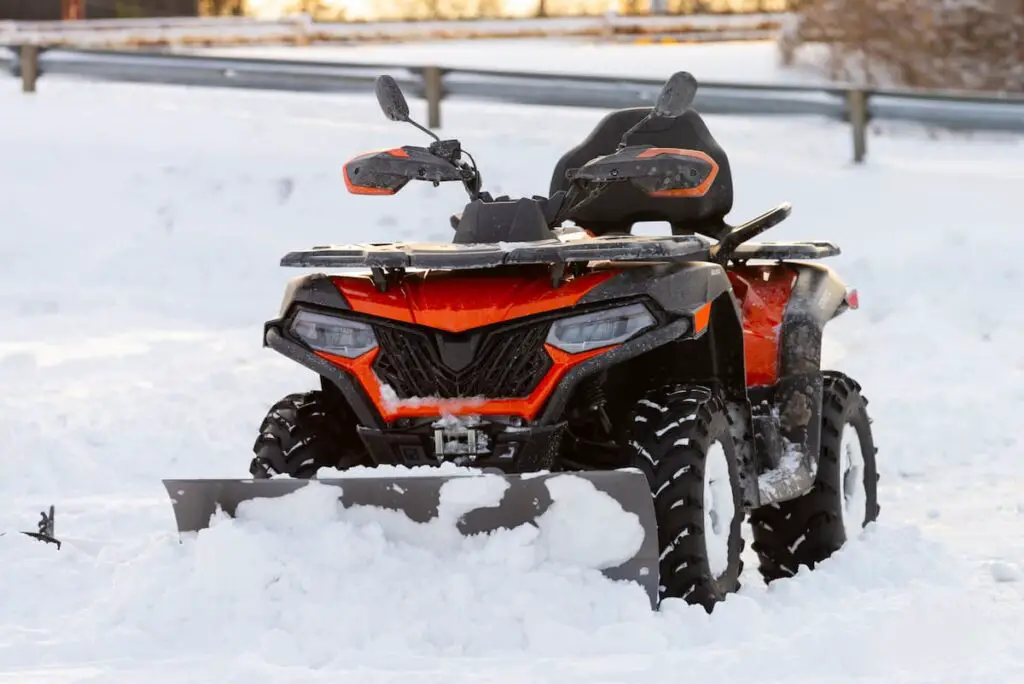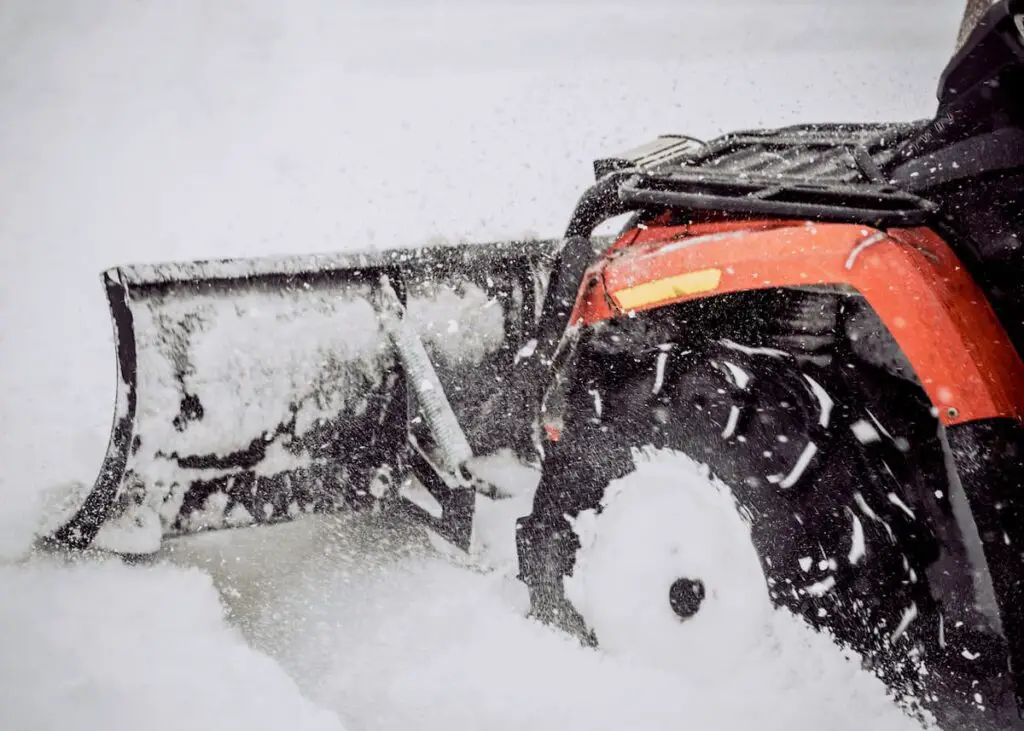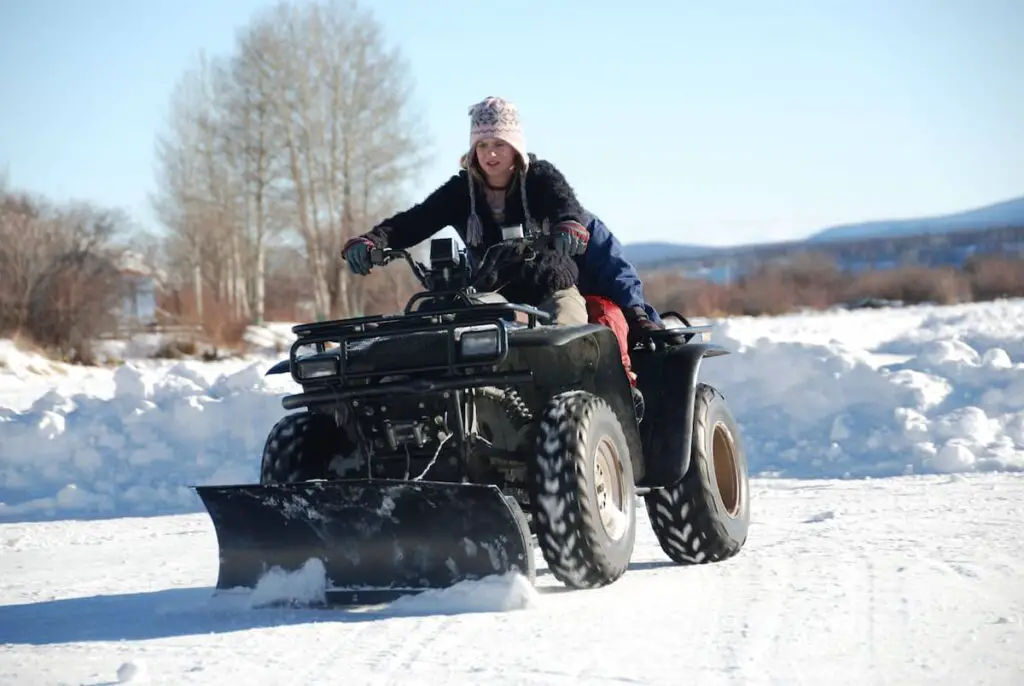As an Amazon Associate, we earn from qualifying purchases. We may also earn commissions if you purchase products from other retailers after clicking on a link from our site.
You bought your ATV to go mudding. Winter is approaching, and you’re thinking of buying a snowplow, but you’re having second thoughts, wondering if a snowplow will damage your ATV.
A snow plow will not be damaged on an ATV. When using one, keep in mind the conditions and your equipment. Don’t overload your ATV and avoid risky behavior that can damage your vehicle or hurt you. Finally, use effective snow plowing techniques to avoid becoming frustrated.
If you’re worried about damaging your ATV, keep reading as we explain what you need to keep in mind and how to avoid doing so. You will also find some tips on how to plow snow on an ATV and an alternative to consider.

Is It Really Possible To Plow Snow on an ATV?
You can plow snow with an ATV, but there are several things you need to consider. These include the level and type of snow, how much power and weight your ATV has, and the type of plow you will use.
Snow
If you intend to plow high traffic spots, expect the snow to be compacted and difficult to plow. Since it hasn’t had time to harden into ice, try to plow fresh snow, unless icy rain is in the forecast.
You will find that your ATV will struggle with snow over a foot high, regardless of how strong it is.
Power
It’s essential to choose an ATV with enough power that can withstand heavy weights. This is more important than finding one with lots of power. Even a 1000cc engine won’t help if you don’t have the weight to push the plow.

Plow Type
ATV plow blades usually are 48 inches (121.92 centimeters) wide, 54 inches (137.16 centimeters) wide, and 60 inches (152.4 centimeters) wide, with different plow heights. Check your owner’s manual to ensure your ATV can manage the plow size you choose. A 48-inch (121.92 centimeters) plow will be enough and will work well on an ATV most of the time.
Blades can be either tapered or straight. Tapered blades move snow up and to the side because of their curved profile. Straight blades plow clearer paths, but the snow builds up, bogging down ATVs.
Therefore, tapered blades are a better choice for ATVs.
How Can You Damage Your ATV With a Snowplow?
You can damage your ATV with a snowplow by overloading your ATV while snow plowing. This can happen if the plow is too heavy, if you’re trying to move too much snow, or you’re plowing at high speeds.
Respect your ATV and plow by treating both with care. Pushing into hard-packed snow mounds can twist the plow blade, cause vehicle damage, and injure the rider or passenger.
Here are a few things to be mindful of when operating an ATV and snowplow:
- It is risky to plow at high speeds since there might be unseen objects or blocks of ice beneath the snow.
- If you hit buried objects at high speeds, you can cause serious damage to the ATV or injure yourself.
- Whenever you need to clear a tall drift, plow in two parts—the upper half first, and then plow the rest.
- Consult the owner’s manual for weight and size limits for a plow and follow them.
How Can I Snowplow Effectively?
You can snowplow effectively by ensuring that snow slides off the blade and setting the plow at the correct angle. Always ensure you are not overloading the snowplow. A little planning can go a long way.

Here are a few tips to enable you to snowplow effectively:
- The plow depth. Set the level on the plow so it will clear snow without being overloaded and also not damage the surface under it. You may also need to adjust the plow depth to match the snow depths.
- The plow angle. The correct plow angle is determined by the contours of the surface and where you want the snow to wind up. Your job will be easier if the angle is adjusted correctly so that you plow on the existing surface slopes. Doing so will help you avoid hitting the ground and damaging the plow blade.
- Keep snow from sticking. To ensure snow slides off the blade, use cooking oil, silicone spray, or another method to keep the snow from sticking.
- Don’t take on deep snowdrifts. Heavy snow may overwhelm the ATV, causing wear and tear or worse. Instead, give yourself extra time to make several passes over the area you want to plow.
- Hidden landscaping. Ensure you know where things such as curbs, landscaping, and children’s toys have been buried by snow. Use sticks or poles to mark permanent features and put away smaller items that can be moved.
- Pile snow at the bottom of a slope. If you move the snow to the higher side, you create a potentially dangerous situation. When the snow freezes, it will form ice sheets, and ice is more dangerous than snow.
- Clean your plow. When you finish plowing, clean your ATV and plow blade. Snow, ice, and dirt will freeze and stick to the plow and ATV. Clean now or deal with a mess next time you get ready to plow.
It should go without saying that following the manufacturer’s maintenance guidelines will extend the life of your ATV.
Use a Snow Blower
Instead of using a snow plow for snow removal, consider using a snowblower instead. An ATV snowblower attaches to the front end, gathers snow, and shoots it out a chute.
Snowblowers for ATVs come in three styles. Single-stage and two-stage are the two most used by homeowners.
- Single-Stage Blowers: These blowers throw snow only once. Snow is scooped and sent into a chute by the auger and then sent out of the chute. These lightweight devices are ideal for driveways and mid-sized yards.
- Two-Stage: These are ideal for snow accumulations of more than 18 inches and allow you to tackle heavy snowfall. Snow is thrown twice with an auger and then an impeller. The auger in a two-stage blower does not touch the ground, and it can be used on concrete and gravel.
Three-stage snow blowers have two augers and would be too heavy for most smaller ATVs.
Should you be interested in a snowblower instead, the following are some features to investigate:
- A sub-frame that runs under the ATVs chassis to improve the stability of the snowblower.
- The caster wheels—larger is better.
- Dash-mounted controls.
- Electric start engine.
- An intake warmer to prevent freezing of the components.
Bottom Line
With the proper equipment and some planning, snow plowing with your ATV can be fun. Maybe not as much fun as mudding, but it’s a lot more relaxing than moving snow the old-fashioned way with a snow shovel.
